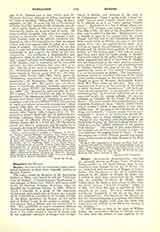

Bangor, ANTIPHONARY OF, an ancient Latin manuscript, supposed to have been originally written at Bangor (Ireland).
The codex, found by Muratori in the Ambrosian Library at Milan, and named by him the “Antiphonary of Bangor” (“Antiphonarium Benchorense”), was brought to Milan from Bobbio with many other books by Cardinal Federigo Borromeo when he founded the Ambrosian Library in 1609. Bobbio, which is situated in a gorge of the Apennines thirty-seven miles northeast of Genoa, was founded by St. Columbanus, a disciple of St. Comgal, founder of the great monastery at Bangor on the south side of Belfast Lough in the county of Down. St. Columbanus died at Bobbio and was buried there in 615. This establishes at once a connection between Bobbio and Bangor, and an examination of the contents of the codex placed it beyond all doubt that it was originally compiled in Bangor and brought thence to Bobbio, not, however, in the time of St. Columbanus. There is in the codex a hymn entitled “ymnum sancti Congilli abbatis nostri”, and he is referred to in it as “nostri patroni Comgilli sancti”. Again there is a list of fifteen abbots, beginning with Comgal and ending with Cronanus who died in 691; the date of the compilation, therefore, may be referred to 680-691. Muratori, however, is careful to state in his preface that the codex, though very old, and in part mutilated, may have been a copy made at Bobbio, by some of the local monks there, from the original service book. It is written, as regards the orthography, the form of the letters, and the dotted ornamentation of the capital letters, in “the Scottic style”, but this, of course, may have been done by Gaelic monks at Bobbio. The actual bearer of the codex from Bangor is generally supposed and stated to have been St. Dungal, who left Ireland early in the ninth century, acquired great celebrity on the Continent, and probably retired to Bobbio towards the close of his life. He bequeathed his books to “the blessed Columbanus”, i.e., to his monastery at Bobbio. The antiphonary, however, cannot be identified with any of the books named in the catalogue of the books bequeathed by Dungal, as given by Muratori (Antiquitatis Italicae Medii Aevi, Milan, 1740, III, 817-824). Here only a summary can be given of the contents of the codex to which the name of “Antiphonary” will be found to be not very applicable: (I) six canticles; (2) twelve metrical hymns; (3) sixty-nine collects for use at the canonical hours; (4) special collects; (5) seventy anthems, or versicles; (6) the Creed; (7) the Pater Noster. The most famous item in the contents is the venerable Eucharistic hymn “Sancti venite Christi corpus sumite”, which is not found in any other ancient text. It was sung at the Communion of the clergy and is headed, “Ymnum quando comonicarent sacerdotes”. A text of the hymn from the old MS. of Bobbio, with a literal translation, is given in “Essays on the Discipline and Constitution of the Early Irish Church,” (p. 166) by Cardinal Moran, who refers to it as that “golden fragment of our ancient Irish Liturgy“. The Creed in this codex differs in its wording from all other forms known to exist. It is in substance the original Creed of Nicea. It does not contain the ex Patre Filioque procedit, but merely states the homoousia of the three Persons of the Holy Trinity.
ARTHUR UA CLERIGH

